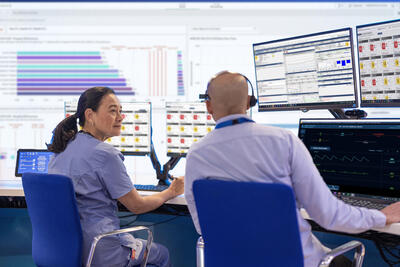Continuous remote monitoring saves scoliosis surgery costs and ICU hours

For scoliosis surgery patients, Royal Perth Hospital has saved costs and reduced ICU hours using health technology provider Philips’ continuous remote monitoring technology. While patients undergoing spinal surgery for scoliosis traditionally require intensive post-operative monitoring in ICUs or high-dependency units — something that can place strain on hospital resources and limit the number of elective procedures that can proceed — a model implemented at the hospital in 2020 sought to offer an alternative.
Called ‘HIVE’ (Health in a Virtual Environment), at Royal Perth Hospital general ward beds were equipped with Philips MX400 bedside monitors, high-resolution medical-grade cameras and a fully integrated clinical command centre powered by the Philips IntelliSpace Critical Care and Anaesthesia (ICCA) and eCareManager platforms; technologies that enabled 24/7 remote patient surveillance by a dedicated clinical team — serving as an additional safety net within in a less intensive and more familiar ward environment.

A study evaluating the clinical and economic impact of HIVE was published in Anesthesia & Analgesia in July, finding that the model reduced ICU hours by 69% and saved $2682 per patient in overall hospital costs, without compromising patient safety. In the study, 288 patients were assessed (155 patients admitted postimplementation and 133 admitted preimplementation), the study showing that HIVE reduced patient time spent in ICU by 17 hours. Importantly, there was no increase in hospital length of stay, emergency readmissions or hospital-acquired complications reported, supporting the safety and reliability of continuous remote monitoring in surgical wards.
Equipped to live-stream vital signs, apply machine learning algorithms continuously assessing patient risk and maintain virtual communication with bedside teams, the remote monitoring centre used AI and continuous data analysis, with early warning signs able to be detected and escalated faster, improving the chances of timely intervention. Philips said the study’s findings aligned with global trends highlighting the value of remote monitoring in hospitals, including its recent work with health systems across North America, the Middle East and Japan.
**************************************************
“The key to HIVE’s success has been the seamless integration of people, process, and technology,” said Dr Kevin Trentino, lead author of the study and Manager of Research and Evaluation with Community & Virtual Care at East Metropolitan Health Service. “Philips’ technology was instrumental in enabling this new model of care, and our findings show the potential to deliver better outcomes at lower costs.” The study can be found at doi.org/10.1213/ANE.0000000000007655.
**************************************************
Phone: 02 9947 0000
Harrison.ai Annalise Enterprise CXR AI chest X-ray
The Harrison.ai Annalise Enterprise CXR module is intended to assist clinicians with...
CareZen Virtual Care Pods
CareZen Virtual Care Pods are modular spaces offering patients a hospital-grade environment for...
Hologic Envision mammography platform
The Hologic 3D Envision mammography platform is built to tilt — a feature engineered to...


![[New Zealand] Transform from Security Awareness to a Security Culture: A Vital Shift for SMB Healthcare — Webinar](https://d1v1e13ebw3o15.cloudfront.net/data/89856/wfmedia_thumb/..jpg)
![[Australia] Transform from Security Awareness to a Security Culture: A Vital Shift for SMB Healthcare — Webinar](https://d1v1e13ebw3o15.cloudfront.net/data/89855/wfmedia_thumb/..jpg)




